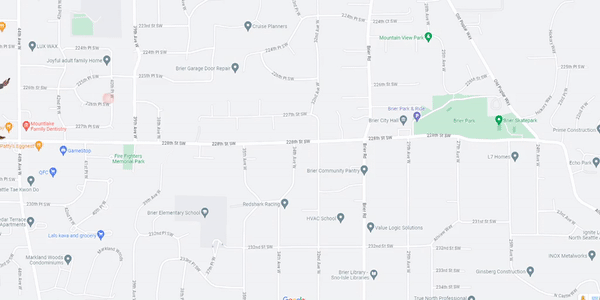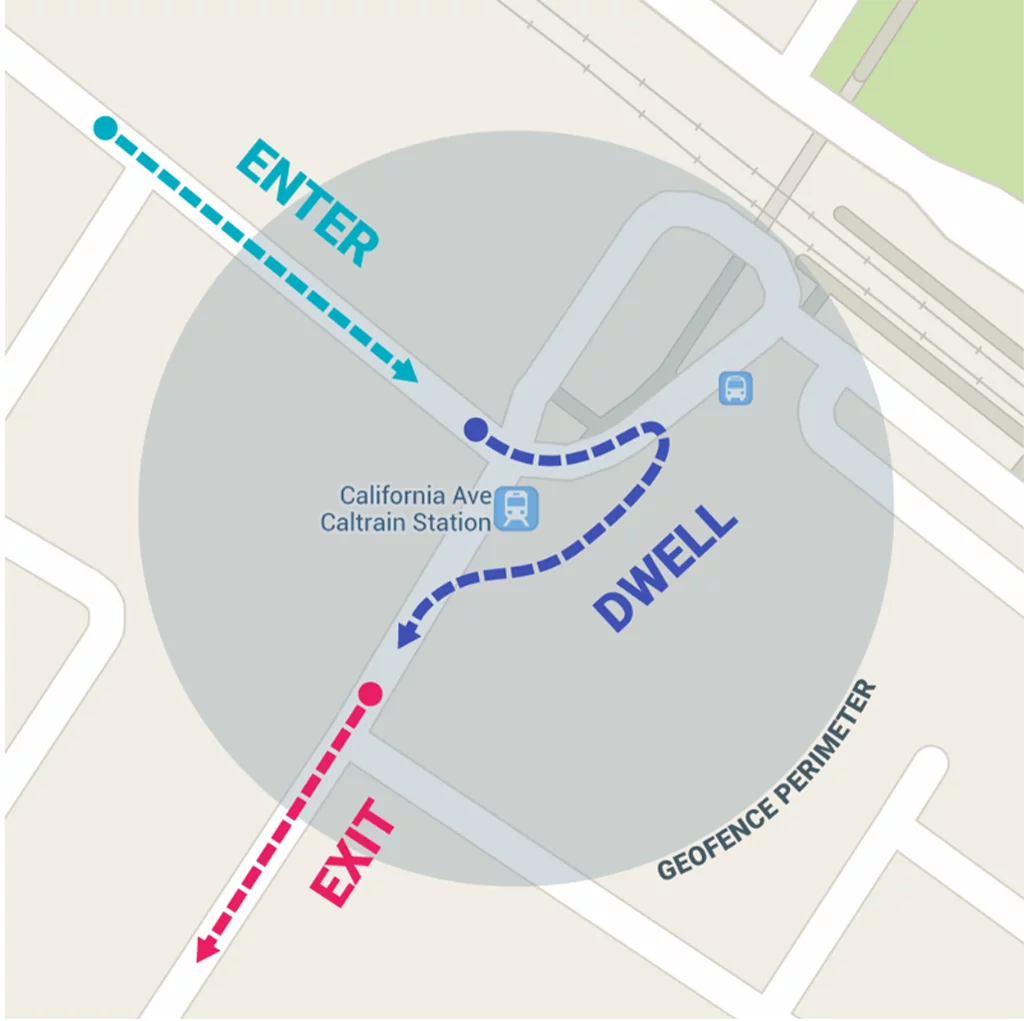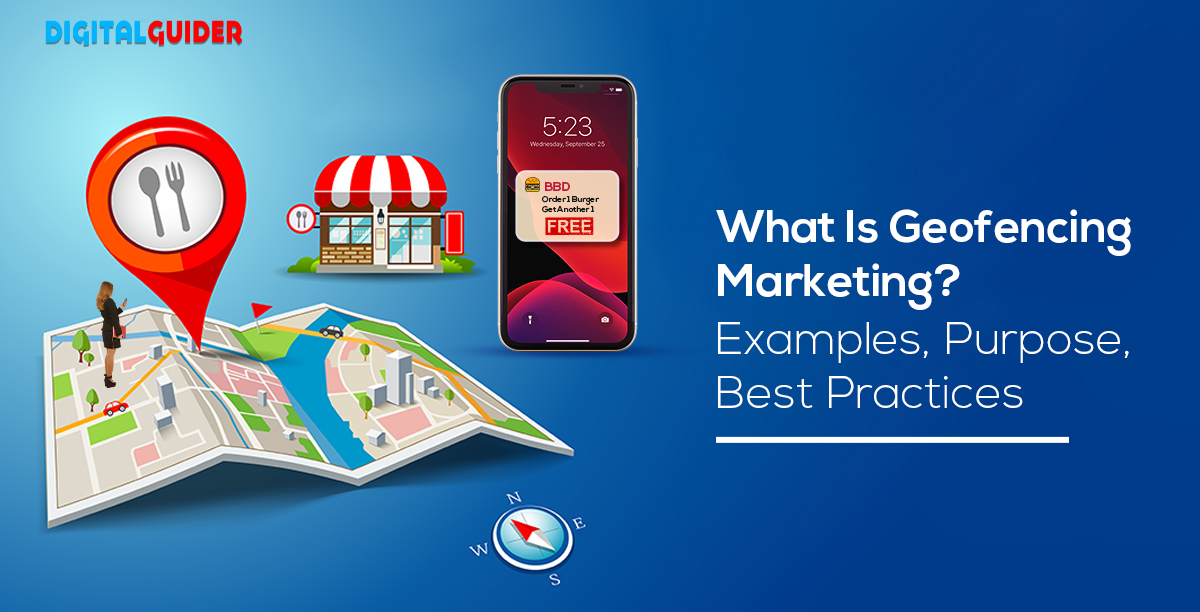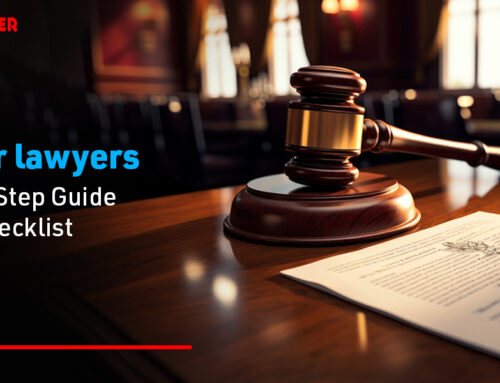Picture yourself exploring a new city, and just as you approach a popular tourist attraction, a notification pops up on your screen, guiding you to nearby discounts at local shops. This seemingly magical moment is not the result of chance; they are the work of geofencing marketing.
There are currently over 6 billion smartphone users worldwide, which is expected to continue to increase over the coming years, as illustrated in the graph below.

Unsurprisingly, location-based marketing (or geofencing) has become a pivotal strategy for small businesses looking to reach mobile users more effectively than desktop users.
But what exactly is geofencing marketing, and how does it benefit your marketing and advertising campaigns?
What is Geofencing?
Geofencing is a type of location-based marketing or advertising. It involves setting up virtual boundaries around the area that tracks whenever someone with a mobile device crosses them. Geofences can be as large as a city block or as small as an individual building. They can also be constructed in a variety of shapes. For example, geofences can be built in round shapes, or, in more complex cases, marketers can create geofences in polygon shapes.
A mobile app or software uses the GPS– Global Positioning System, radio frequency identification, cellular data, or Wi-Fi to define a virtual geographical boundary. It triggers a targeted marketing action when a device enters or exits that boundary. This boundary is known as a geofence. An alert or notification is sent to the user who advertises a nearby store, brand, service, or product. This is sometimes also referred to as geofencing advertising, and it’s a technique for more accurately targeting a company’s most likely customers.
What Is The Purpose Of Geofencing?
To understand why, first understand how traditional advertising works. To persuade a broad audience, a business invests in ads through mass media channels (e.g., TV, radio, newspapers, magazines, and flyers). In this approach, they may also reach people who have no interest in the company’s offers, products, or services.

On the other hand, geofencing enables businesses to define precise geographical areas within which their advertisements will be placed. This approach allows businesses to target nearby customers who are more likely to visit a particular business based on proximity, brand similarity, demographic characteristics, and other factors. Geofencing allows your app to monitor users precisely, target them, or notify them of a mobile device entering or leaving a given location. This approach is much more efficient and cost-effective than relying on large-scale, highly unpredictable, and costly mass-branded advertising.
Common Examples Of Geofencing:
Marketers in different industries already use geofencing to get creative with their campaigns. For example, if you’re a student or a working professional and walk past a computer store, you’ll get a text saying, “Today Only! Buy A Laptop And Get An E-reader Free Now!” This text is sent to you because you’re near the store’s geofence, automatically triggering a specific marketing action. You could also get geofenced notifications from your app, social media posts, push alerts, emails, and more.
There are many different ways to use geofencing, so here are some creative ways marketers in various industries already use it.
- Coupons: Evaluating the ROI of coupons by leveraging location data to monitor coupon-based store visits.
- Mobile payments: Remind users of locations where they can pay at the time of their visit.
- Hospitality: Receiving feedback shortly after guests leave the hotel.
- Retail: Sending promotional messages as shoppers pass a store to drive visits.
- Travel: Enriching user profiles with traveling history to supercharge future targeting.
- Coffee chain: Giving out offers/discounts to returning customers to foster loyalty.
- Automotive: Retargeting users who have visited an automotive dealership, whether yours or that of a competitor.
- Airline: Providing flyers with expedited airline service upon arrival at the airport.
- Dining reviews: Recommending a list of popular dishes to a guest who visits a particular restaurant.
- Home automation: The thermostat lowers when a smartphone user leaves a geofenced home.
- Fleet & asset management: Tracking vehicle’s location with geofencing.
- Geofencing in cars: This is also a concept. It is commonly used for surveillance and monitoring purposes.
- Human resources: When employees come in or go out, their smart card will alert them.
- Online store: Geo-conquesting competitor’s locations with deals to lure customers away.
Segmentation Of Geofence Marketing
The geofencing market, as reported by Straits Research, can be divided into components, types, technologies, deployment channels, and verticals.
— Based on Type
- Fixed Geofencing
Fixed geofencing involves establishing virtual boundaries around specific locations. This type is particularly effective for businesses with a physical presence, enabling them to engage customers within a defined proximity.
- Mobile Geofencing
On the other hand, mobile geofencing revolves around targeting users based on their mobile device’s location. This type offers a dynamic approach, engaging potential customers as they move through different areas.
— Based on Component
- Service
Geofencing Services offer various services to assist businesses in effectively implementing and managing geofencing initiatives. These services may include consulting, analytics, and technical support.
- Solution
Geofencing solutions are comprehensive packages that provide businesses with the tools and technologies necessary to execute geofencing campaigns. These solutions often include software platforms, hardware integration, and user interfaces.
— Based on Technology
- GPS
Leveraging satellite-based positioning, GPS technology enables precise location tracking, making it a fundamental tool in geofencing applications.
- RFID
Radio-Frequency Identification (RFID) utilizes radio waves to identify and track objects within a defined range. This technology is beneficial in contexts where physical tags can be attached to assets.
- Wi-Fi
Wi-Fi-based geofencing relies on detecting Wi-Fi networks to determine a device’s location. This approach is often utilized in indoor environments.
- Cellular Network
Cellular network-based geofencing employs data from mobile towers to approximate a device’s location. This technology is widely applicable due to the ubiquity of cellular coverage.
— Based on Application
Geofencing’s applications are diverse and varied across industries. Key sectors include –
- Transportation & Logistics
- Retail
- Automotive
- BFSI
- Public Sector
- Hospitality
- Media & Entertainment
Each industry benefits from geofencing’s ability to provide location-sensitive and context-aware marketing messages to target audiences.
— Based on Deployment
- On-premise
On-premises deployment is when the geofencing application is hosted on your organization’s infrastructure. This gives you more control and flexibility.
- On cloud
Cloud-based deployment entails hosting the solution on external servers. It offers scalability, accessibility, and potentially reduced maintenance efforts.
— Based on Vertical
Geofencing vertical segmentation covers a broad range of industries-
- Retail Sector
- Healthcare
- Public Sector
- Events
- Law
- Logistics & Transportation
Verticals benefit from customized geofencing solutions that meet their respective industries’ specific needs and goals.
How is Geofencing Implemented in Marketing Strategy?
Geofence marketing is a comprehensive marketing strategy that can be applied to businesses and brands of all sizes and needs. Geofences can be established up to 1000 meters away from each other and up to 200 meters away from one another. This powerful marketing technique enables users to interact with businesses based on their hyperlocal marketing location.

Let’s understand better how geofence marketing actually works through an example –
- A geofence is created by the company for a predetermined geographical area, and an advertisement campaign is created for that geofence.
- A user enters the geofenced area during the set timeframe and gets included in the advertising audience.
- While using various apps on your phone or browsing the web on your mobile browser, he will start to see advertisements from that advertiser through in-app promotions, notifications, or coupons.
- Users may view these Ads for a period of 1 day and up to 30 days after they have joined the geo fence.

GIF Source: Webengage
In the above GIF, two activities occur:
- A mobile device enters into the created geofence
- And the device takes exit from the said geofence.
Once the geofence has been set up, the system can take any action when the user comes in or goes out at your request.
A geo-targeted marketing campaign can include promotions, discounts, invites, or a welcome message. The geo-targeted ads can be placed on apps and websites during that time for maximum impact.
How Marketers Use The Geofencing Strategy?
Geofencing has become an effective tool for marketers to engage with their target audience in real time and improve the overall customer experience. Let’s look at some of the most common ways marketers use location technology:
— Brand Mobile Applications:
Many brands have their apps. Marketers can integrate geofencing capabilities into their brand’s mobile applications. Geofencing plugins can be added to any app to allow marketers to alert users when they enter or leave the geofenced space (for example, a store, event space, or tourist destination). The app can trigger personalized messages, discounts, or notifications. This approach can enhance customer engagement, encourage in-store visits, and create a seamless shopping experience.
Also Read: Why Is Responsive Web Design Important?
— Location-Based Web Ads:
Location-based advertising can be displayed on search engines like Google when users navigate a geographical area. For example, if someone searches for “restaurants near me,” geofencing technology can display relevant ads for nearby eateries. This ensures that ads are more relevant to users’ immediate needs and increases the likelihood of conversion.
— Text Messages:
Mobile users can receive text messages when they navigate to a designated area. Retailers, for instance, can send exclusive discounts or promotions to potential customers near their brick-and-mortar stores. The immediacy of text messages can drive foot traffic and spur impulse purchases.
— Social Media Ads:
Social media ads can serve consumers across a geofence. Marketers can create geofenced advertisements that are shown to users within a particular radius of a physical location. This tactic is beneficial for promoting events, pop-up shops, or attracting visitors to physical stores.
— Third-party apps:
Many brands utilize third-party apps, such as coupon apps, to send their users location-based notifications. For instance, a retail chain may partner with a popular navigation app or a weather app to display targeted ads or promotions when users are close to their store locations. This approach extends the reach of geofencing campaigns beyond just the brand’s app users.
How Does Geofencing Marketing Work?
Getting started with geofencing is easy: All you need is an app and geofencing coordinates. As we said, this isn’t something every customer has access to (at least not yet), so make sure to let your existing social media followers know that you’re now actively promoting geofencing.
The best way to get geofencing up and running is to be proactive. Before you launch, take a look at all the typical elements of your current marketing campaign, such as:
— Know Customer Demographics and Insights
Before you jump into geofencing marketing, you must understand your customer’s demographics and what your local customers look like. This will help you make sure the promotions you’re running are the most effective and get the results you’re looking for.
If you’re unsure who makes up your target audience — or is revamping your target audience — look at the data you already have available. If you’re active on social media, for example, interact with your customers and see what they say about your business, services, or products.
— Targeting Methods
INMOBI says there are a few different types of targeting you can do with geo-geofencing, like context-based targeting, daily content targeting, retargeting, and more. These options allow you to tailor and target different groups of people.
— Combine geofencing with behavioral targeting
To increase the success of your geofencing campaign, consider combining location-based advertisements with behavioral targeting. This is often useful for companies that have audiences with specific interests, like art museums or candy stores, rather than companies that provide necessary services, like supermarkets and auto mechanics. You can use behavioral targeting through data collected from computers and mobile devices to display more personalized advertisements.
Must Read: 15 Ways to Optimize Your Google Business Profile (GMB) to Rank Locally
— Keep your geofencing boundary small
The general rule of thumb for geofencing is a four to five-minute travel radius. For example, if you’re in an urban area where most people walk from A to B, you’ll want to keep your geofence radius at a four to five minutes walking radius. On the other hand, if most people drive, then a four to five minutes transport radius is the maximum you’ll achieve.
The last thing you want is for your geofence area to be too large. If your boundary is too large, you could end up marketing your brand to the wrong people.

Image Source: Survey Insights
— Respect Customer’s Privacy
Be open and honest with your mobile customers. Make sure they know how you can access their data, primarily via the app they’re using. It’ll give them the trust and confidence to talk to your app and your location marketing. They’ll likely buy from your brand if you make them feel comfortable.
— Create Compelling Ads
It’s not enough to mention what you sell; highlight in-store offers or reward customers for responding to your ad. If your target audience already knows who you are, they’ll be more likely to come in if you give them a good reason to do so.
For example, let’s look at a personalized alert that Starbucks sends to its local shoppers. Not only does it include their name, but it also includes a promo for their favorite drink.

Starbucks now
Hi Eddie! You are near Starbucks Oxford St. Currently, 50% off on your favorite drink: Mocha Cookie Crumble!
— Add a Compelling CTA
Finally, add a captivating call-to-action (CTA) to make the offer more attractive, such as “Come in and enjoy our dinner special.”
According to a Reveal Mobile report, the most effective call-to-actions (CTAs) for geo-targeted ads include:
- Learn more
- Shop now!
- Buy now
- Click here
It’s also worth noting that you should develop ads that aren’t spammy or self-serving. If you’re promoting a new product, invite users to try it versus telling them to buy it. With this approach, you’re guiding them through the buying funnel naturally. Marketers had a lot of success with other calls to action, like “order now,” “click to save,” “call now,” and “shop online.”
Conclusion- Analyze And Optimize Your Geofencing Marketing Campaign
Get the most out of your geofencing campaigns. There are many ways to optimize your geofencing efforts, and analytics will help you get the most out of them. When running ads, consider metrics like visit rate, click-through rate, and the cost-per-visit for your advertisements to determine what changes you can make to your campaign for improved outcomes. Try to examine various metrics to create an overall view of your geofencing campaign’s performance rather than looking only at one metric for information.
Apply geofencing best practices to drive more customers.
Connect with our experts for a free consultation. or call us today!







